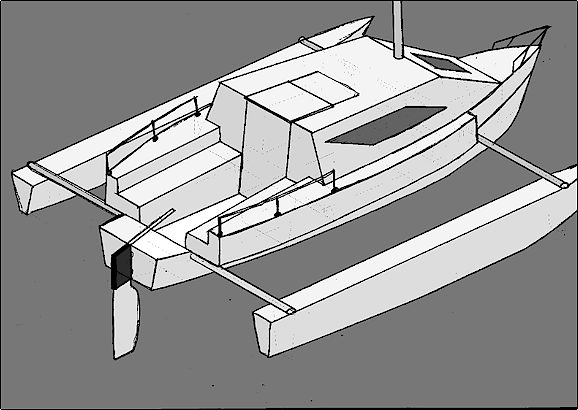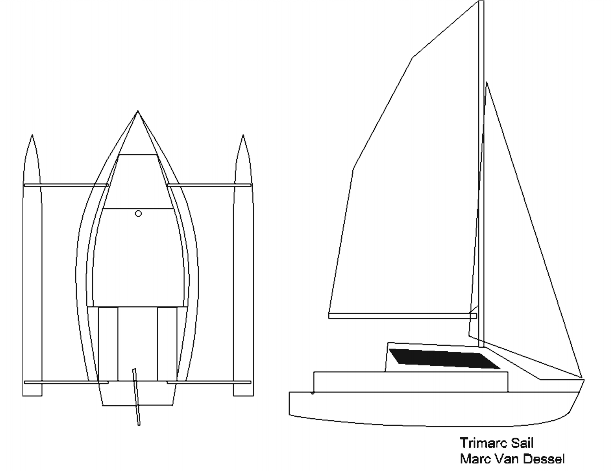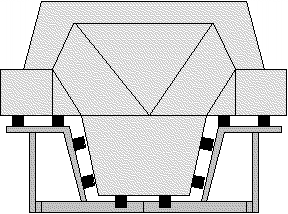|
Trimarc
A folding 6m trimaran
Marc Van Dessel marc.vandessel@siemens.atea.be
Specifications
| Length overall |
6.00 m |
| Length waterline |
5.60 m |
| Length Trailering |
7.10 m |
| Beam Sailing |
4.70 m |
| Beam Trailering |
2.50 m |
| Draught |
0.30 m |
| Interior headroom |
1.65 m |
| Displacement empty |
500 kg |
| Ballast |
N.A. |
| Trailering weight |
500 + 200 kg |
| Sail area |
14 + 6 Sq. M |
| Mast height above WL |
8.40 m |
| Sleeps |
2 |
| Sails |
4 |
| Building complexity |
high |
| Performance |
good |
| Luxury |
good |
Description
This design offers a lot of interior space while
keeping good performance.
Exterior
- The main hull is narrow at the waterline and wide at seating level.
- The cockpit is good protected and has comfortable seats.
- The floats can be folded up using simple hinges. It is essential that
these floats are light (+/- 30kg) to make this possible. For safety it is best to aid the
raising or lowering with blocks and line (3 to 1 reduction). The beams are each made of 3
parts of standard aluminum tubing. The central parts of the tubing are fixed to the hull.
The outer tubes are connected to these central tubes by bolts. When the floats are lowered
a second set of bolds secure the tubes together.
Interior
- Entering the cabin, one can find the galley on starboard. Full standing
headroom is obtained by opening the hatch. Otherwise one can cook while seated on the
opposite bench.
- The rest of the cabin is a giant dinette, which seats 5.
- At night the table is lowered to form a king-size berth (2.00m x 2.00m).
- There is easy accessible storage room behind the back of the benches and
at the entry. Other storage space (for a porta-potti) is found under the forward part of
the dinette.
- The forward part of the cabin floor is raised to make sitting more
comfortable.
Stability
- The boat gets all his stability from the floats. No ballast is needed and
the main hull is very slender at the waterline. This gives good performance and level
sailing.
Sail
- The rig is not extreme, making things easier for cruising.
- The mainsail has a fairly big roach. This keeps the center of effort
lower and limits the mast length to 7 m (easier for trailering).
- A rather small jib is used. This makes tacking much easier, and
doesn’t need a winch.
Motor
- A standard outboard: 5HP 4 stroke.
Trailer
- A standard trailer can be modified. On both sides extra supports are
welded to support the main hull. Using a lot of rollers make launching and retrieving
easier.
- The floats can be lowered while the boat is on the trailer.
Building technique
- Stitch and glue with 8 mm ply is used. Every exposed surface is to be
covered with glass and epoxy.
- The simple hull form (flat bottom) makes building easier.
Time to build
Cost
- 8000$ including motor and trailer
Pro's
- Combines good performance with comfortable sailing and cruising
- light : easy to trailer, easy to launch, easy to handle, fast
- self modified trailer
- very small draught
- full size berth
- cheaper than other folding mechanisms
- self draining cockpit
Con’s
- more complicated to build
- more time needed to launch than a monohull
|
Drawings






|